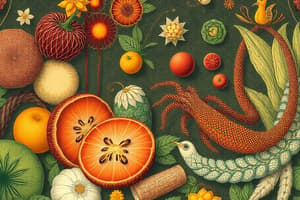Podcast
Questions and Answers
Which of the following is NOT considered a primary source of food?
Which of the following is NOT considered a primary source of food?
- Grains like wheat and rice
- Legumes such as beans and lentils
- Processed snacks and ready-to-eat meals (correct)
- Livestock including cattle and pigs
What type of food system involves the farming of aquatic organisms?
What type of food system involves the farming of aquatic organisms?
- Permaculture
- Agriculture
- Aquaculture (correct)
- Foraging
Which alternative food source is gaining recognition for its sustainability?
Which alternative food source is gaining recognition for its sustainability?
- Wheat
- Insects (correct)
- Seafood
- Canned goods
Which of the following food practices focuses on reducing waste and conserving resources?
Which of the following food practices focuses on reducing waste and conserving resources?
Which fermented product is known for providing probiotics?
Which fermented product is known for providing probiotics?
Which of the following factors can influence dietary preferences in different regions?
Which of the following factors can influence dietary preferences in different regions?
Which type of food security involves access to safe and nutritious food?
Which type of food security involves access to safe and nutritious food?
Which of the following is a major food crop that falls under the primary source category?
Which of the following is a major food crop that falls under the primary source category?
Which of the following best describes plant-based proteins?
Which of the following best describes plant-based proteins?
Which practice is NOT typically associated with sustainable agriculture?
Which practice is NOT typically associated with sustainable agriculture?
Flashcards are hidden until you start studying
Study Notes
Sources of Food
1. Primary Sources
-
Plants:
- Major food crops: grains (wheat, rice, maize), fruits (apples, bananas), vegetables (carrots, spinach).
- Legumes (beans, lentils) provide protein and essential nutrients.
-
Animals:
- Livestock (cattle, pigs, sheep) for meat, milk, and eggs.
- Fish and seafood: rich in proteins and omega-3 fatty acids.
2. Secondary Sources
-
Processed Foods:
- Derived from primary sources, often altered for preservation or convenience (e.g., canned goods, frozen meals).
- Includes snacks, beverages, and ready-to-eat meals.
-
Fermented Products:
- Examples: yogurt, cheese, sauerkraut, and kimchi.
- Provide probiotics and enhance flavor.
3. Alternative Sources
-
Insects:
- High in protein, vitamins, and minerals; increasingly recognized as a sustainable food source.
-
Algae:
- Spirulina and chlorella are examples; rich in protein and micronutrients.
-
Plant-based Proteins:
- Sources like tofu, tempeh, and seitan cater to vegetarian and vegan diets.
4. Food Systems
-
Agriculture:
- Involves crop cultivation and animal husbandry.
- Practices include organic farming, sustainable agriculture, and conventional farming.
-
Aquaculture:
- Farming of aquatic organisms (fish, crustaceans) for food.
-
Foraging:
- Gathering wild plants, fungi, and hunting for natural food sources.
5. Global Variations
-
Cultural Influences:
- Dietary preferences vary significantly by region due to climate, tradition, and available resources.
-
Food Security:
- Access to sufficient, safe, and nutritious food is crucial for health and well-being; varies globally.
6. Environmental Impact
-
Sustainable Practices:
- Emphasis on reducing waste, conserving water, and promoting biodiversity.
-
Impact of Food Production:
- Agriculture contributes to greenhouse gas emissions; sustainable methods aim to mitigate this effect.
Sources of Food
Primary Sources
- Plants: Major food crops include grains like wheat, rice, and maize; fruits such as apples and bananas; and vegetables like carrots and spinach.
- Legumes, including beans and lentils, are crucial sources of protein and essential nutrients.
- Animals: Livestock, such as cattle, pigs, and sheep, are primary sources for meat, milk, and eggs, while fish and seafood provide high-protein options rich in omega-3 fatty acids.
Secondary Sources
- Processed Foods: These foods are derived from primary sources and modified for preservation or convenience, including canned goods, frozen meals, snacks, beverages, and ready-to-eat meals.
- Fermented Products: Such as yogurt, cheese, sauerkraut, and kimchi, which not only enhance flavor but also supply probiotics beneficial for gut health.
Alternative Sources
- Insects: Recognized as a sustainable food source, insects are rich in protein, vitamins, and minerals, gaining popularity in various diets.
- Algae: Spirulina and chlorella are nutrient-dense examples that offer protein and essential micronutrients.
- Plant-based Proteins: Options like tofu, tempeh, and seitan cater to vegetarian and vegan dietary choices.
Food Systems
- Agriculture: Involves the cultivation of crops and livestock, incorporating practices like organic and conventional farming, as well as sustainable agriculture methods.
- Aquaculture: Focused on farming aquatic organisms including fish and crustaceans for food, supporting both local and global food supply.
- Foraging: Involves gathering wild plants, fungi, and engaging in hunting to access natural food sources.
Global Variations
- Cultural Influences: Dietary preferences differ across regions, shaped by factors such as climate, cultural traditions, and resource availability.
- Food Security: Ensuring access to sufficient, safe, and nutritious food is essential for health and well-being, with significant variability in access around the globe.
Environmental Impact
- Sustainable Practices: Focus on reducing food waste, conserving water resources, and enhancing biodiversity through environmentally friendly strategies.
- Impact of Food Production: Traditional agricultural practices can contribute to greenhouse gas emissions, leading to increased efforts in adopting sustainable methods to mitigate environmental harm.
Studying That Suits You
Use AI to generate personalized quizzes and flashcards to suit your learning preferences.




